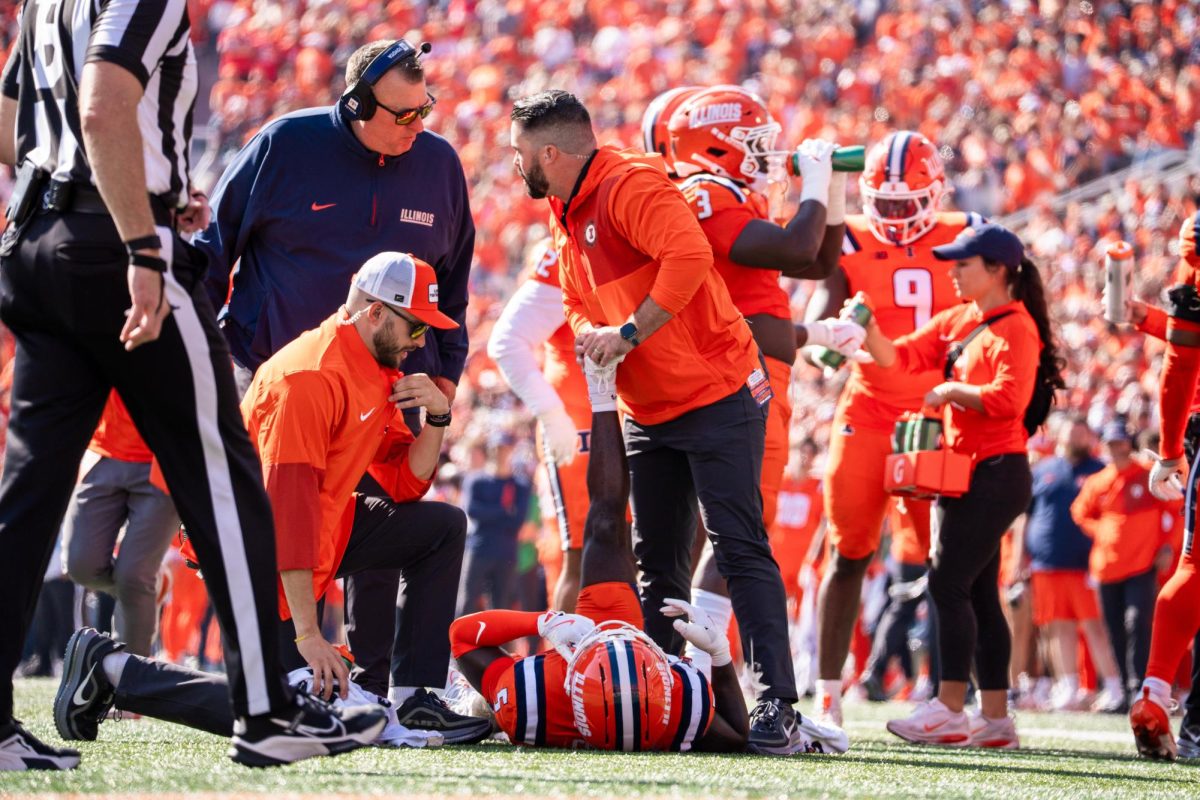Shortly after the University was founded in 1867, secret brotherhood societies called fraternities appeared on campus. Flash forward 144 years and the U of I is said to have the largest Greek system in the country. While the system has withstood the test of time, some traditions that helped shape Greek history on campus have not. The Daily Illini searched through hundreds of archived copies of stories that date as far back as the 1920s to find some of the top traditions that once defined Greek life at the U of I.
10. Extravagant Rush
The story goes that the formal sorority recruitment process, called rush, got its name from sorority members having to rush to train stations to grab and recruit incoming freshmen before the new students found alternative housing, said Ashley Dye, assistant dean of students for fraternity and sorority affairs.
Eventually, the Panhellenic Council (PHC), which oversees campus sororities, formalized the event, transforming it into a complex, organized process. Interested women would have to sign up and visit the various sorority houses per schedule and planned events. Some sororities went deep into chapter budgets to present costumed skits and to give gifts to potential members. Singing and clapping outside was also a tradition. In 1993, the national PHC implemented new rules to control some of the traditions. The changes suggested the ladies keep their singing and skits indoors, spend no more than $4,000 from chapter funds and refrain from giving gifts of any kind. These rules are still in effect today.
9. Formal, Informal Rush
Get The Daily Illini in your inbox!
Rushing a fraternity is far less complex than rushing a sorority. There is no obligation, no registration, no singing, no clapping and no skits. Instead, men interested in joining a fraternity can visit the events and houses they want. This can be a disadvantage to some fraternities, as students have often neglected visiting some houses for the ones they know more about or are more comfortable with. The Interfraternity Council (IFC), which governs campus fraternities, attempted to tackle this issue in the 1980s and 90s with more formalized rush events. In the 80s, there were sign-up requirements and schedules. By the early 90s, the IFC divided houses into districts that held rush events together on scheduled days. In the late 90s, the district rush was exchanged for guided tours that let interested students visit all houses before making a choice.
“We don’t do any of those things now,” Dye said. “Those ideas came and went during that span of mid to late 90s, maybe even early 2000s.”
8. Little Sisters Program
The idea was simple: pair a sorority sister with a fraternity. She would help the house with parties and events. Little Sister programs became very popular by the 1970s, Dye said. But by the late 80s, the PHC thought the program blurred lines. The “little sisters” were often given subservient roles and, according to one Daily Illini article from 1989, the women were sometimes pursued as romantic interests rather than for friendship. The program also blurred lines of membership and keeping houses single-gendered, Dye said.
“They were really recruiting kind of a second-class member, recruiting women to be what they called little sisters, but providing them some privileges of membership, but not full membership,” Dye said.
The program was discontinued in 1989.
7. Sororities and alcohol
Who’s liable? This was a question members of the national PHC asked during a time when having dry sororities hosting events at wet fraternity houses raised concerns about liability and insurance. The council finally passed Alcohol Free 2000, which banned sororities from co-sponsoring events with fraternities if alcohol would be served. A year later, the council added the Alcohol Free Resolution to the policy, which limited the number of sorority members that could attend a fraternity sponsored event where alcohol is served. The rules are still in effect.
6. Bid night
For incoming pledge sisters, an initiation into a sorority can be a joyous occasion. Bid night was a time to celebrate the moment. Fraternities also took part, hosting the events in their houses. Traditionally, fraternity members bought the new sorority sisters gifts like flowers. As time went on, however, the pledges were given less flowers and more alcohol, according to one Daily Illini article. The night became a huge party that would often get out of control, it said. Safety concerns and fears of sexual assault caused the PHC to cancel the event in 2000. Instead, houses focused on Greek Week and a Panhellinic Initiation Ceremony where men were not allowed.
5. Greek Week and the Greek Olympics
It was a week of fun competition, barbecues and sports. The annual Greek Week highlighted a Greek Olympics in which houses competed in sports and activities to earn participation points. The house with the most points at the end of the celebration won a special trophy. The event was dropped last fall in exchange for a heavier Greek presence during Homecoming Week. There are no plans of renewing the tradition any time soon, Dye said.
4. Kegs
Frat parties are strictly BYOB. This wasn’t always the case. Due to rising liability costs, in the 1980s, national chapters and some IFC members lobbied for a ban on alcohol in houses. In 1989, the IFC voted to ban kegs at fraternity parties. There was some confusion as to if this meant all alcohol or just kegs were banned. Some fraternities continued to serve drinks until a much clearer ban was established in 1997. The new policy was included in the risk management program called Kolusis. The new rules, still in effect, state drinkers must be 21 or older, have wristbands and must check-in their booze at a drinking table for redeemable beer tickets. “If you did not bring it, you can’t drink it,” the rules say.
3. Intramurals and the Participation trophy
Intramural sports began with Greek systems, said Erik Riha, lead assistant director of marketing in Campus Recreation. Houses at universities would form teams and compete against one another. In the 1920s, the University intramural program began awarding points to houses based on how much members participated in the games. At the end of the year, the house with the most participation points was awarded the Participation Cup trophy. The trophy was highly coveted by fraternities that would also earn bragging rights for the next year. Rivalries formed and some houses played sports their members weren’t interested in just to earn points, according to 1975 articles. It grew so competitive that the system was discontinued in 1975. Intramural organizers at the time said the event out-served its original purpose of getting students excited about sports.
“It’s changed over the years to suit the student culture and the student needs and what works best to get everybody involved,” Riha said.
Today, campus intramurals are still popular and competitive among fraternities, said Riha. There is a fraternity division in the intramural program, but no elaborate cup is awarded.
2. Greeks in The Daily Illini
Ads for initiations, formals, philanthropies and invitations used to fill pages of the Daily Illini prior to the late 1990s. Some ads were invitations for specific individuals or a chance to brag about winning an intramural game. There was a Greek news beat, a Greek reporter and a special Greek section in the Daily Illini personals. The sports section also covered fraternity intramurals like any other sport.
In 1992, however, the PHC and IFC announced they’d be boycotting The Daily Illini, calling the reporting unfair and lacking objectivity. The relationship was soon mended only to be tried again four years later. This time, the councils called another boycott days after a Daily Illini columnist called the Greek system a “racist, classist, sexist, homophobic, heterosexist, elitist, Christo-centric, repressive and oppressive institution.” Two weeks later the boycott was called off. The councils said the boycott had nothing to do with column, but with what they felt were unresponsive and non-objective reporters. There’s no boycott today, but Greek ads are not as prevalent.
Nancy Elliott, sales director for Illini Media, said this may be because student organizations have better, cheaper ways of advertising.
“I wouldn’t say it came directly from the boycott,” Elliott said. “I just think in general, the budgets have been tighter and they’re not spending as much on ads.”
1. The Iron Clad Pledge
According to a Daily Illini article, U of I’s Greek system almost didn’t happen. When fraternities first hit the campus in the late 1800s, some were un-charted and functioning as secret, underground societies. These selective, self-governing bodies did not sit well with University President Selim Peabody. University leaders disliked the societies so much they enacted the Iron Clad Pledge, a vow every incoming student had to make, promising not to join a fraternity or secret society. Upon graduation, the students were to also promise they did not participate in any secret society while attending the University. By 1891 the rule ended, allowing underground frats to be charted, eventually creating the largest Greek system in the country.
Mary Beard contributed to this story.





